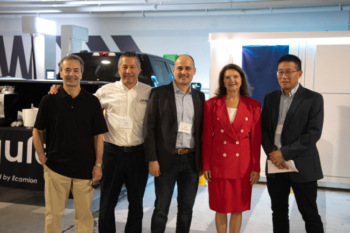From the plastic keys of your keyboard to the jet fuel that powers your flight home for the holidays, engineers are finding methods to make everyday life more affordable and more sustainable.
“It is vital to closely examine the processes and infrastructure of our daily lives and ensure that they are efficient and sustainable,” said Professor Bryan Karney (CivE), associate dean, cross-disciplinary programs, and academic director, Sustainability Office. “Education is one major part of that. We need to teach young people about how these processes work together to contribute to climate change.”
Karney is one of many engineering professors at the University of Toronto who are making strides toward sustainability in research, teaching and lifestyle.
Learn more about Karney and three other professors who are engineering a greener future:
Bryan Karney (CivE) — Systems of sustainability
 When it comes to sustainability, Professor Bryan Karney (CivE) believes that enough small changes, and a few big ones, can make an enormous difference.
When it comes to sustainability, Professor Bryan Karney (CivE) believes that enough small changes, and a few big ones, can make an enormous difference.
“For as long as I can remember, I’ve been fascinated by things that work well,” said Karney. “I sought to learn the mechanisms behind what makes some things last for centuries.”
Karney is an expert in the field of water resource and energy systems, with specialization in infrastructure renewal and the design and analysis of water distribution. He has published hundreds of research papers and consulted on several projects in the city of Toronto, including the hydraulic review of Pearson International Airport jet fuel distribution system.
Karney’s passion for sustainability is perhaps most evident in his innovative and award-winning approach to teaching.
“Students are delightfully interested in sustainability and making a difference,” Karney said. “We need to harness that enthusiasm and give them a sense of perspective and responsibility.”
In 2013, he created a free Massive Open Online Course (MOOC) titled, Our Energetic Earth, which explored the interconnectedness of the forces of nature. As associate dean, cross-disciplinary programs in the Division of Environmental Engineering & Energy Systems, Karney has spearheaded the development of a number of courses and minors related to sustainability, including the Environmental Engineering Minor.
“The thrust of my work is involved in water and energy, but that includes many components, from policy and infrastructure, to how the University can become more sustainable,” said Karney.
“I think about systems telescopically: I examine the ways in which small changes and mechanisms can have a big impact on other systems. On a personal level, that means making lifestyle choices both small and large, from recycling and riding the subway, to influencing policy and education.”
Omer Gulder (UTIAS) — Clean combustion takes flight
 Next time you think about booking a flight, think about Professor Omer Gulder (UTIAS).
Next time you think about booking a flight, think about Professor Omer Gulder (UTIAS).
He and his colleagues at the University of Toronto Institute for Aerospace studies are currently developing novel bio-based fuels that could reduce the carbon and soot emissions of air travel by up to fifty per cent.
“There are many road blocks to developing viable alternative fuels for aircraft,” said Gulder. “They not only need to be cost effective, but they also have to work with existing engine technologies.”
Gulder is testing several methods of mixing and processing biofuels so that they mimic conventional jet fuel, while maximizing efficiency and minimizing emissions.
“I am inspired by the complexity of environmental challenges,” said Gulder, who has been researching alternative fuels for transportation since the 1970s. “There is no one fix-all solution, we all have to do our part. Educating people on the importance of sustainability is vital, and something this Faculty takes very seriously.”
Jennifer Drake (CivE) — A green roof for the perfect storm
 In the spring of 2009, the city of Toronto instituted the Green Roof Bylaw, requiring that all new commercial, industrial, residential and institutional buildings with a gross floor area greater than 2,000 square metres include a green roof system.
In the spring of 2009, the city of Toronto instituted the Green Roof Bylaw, requiring that all new commercial, industrial, residential and institutional buildings with a gross floor area greater than 2,000 square metres include a green roof system.
“During a storm, green roofs absorb and filter water, reducing strain on the sewage system and restoring some natural stages of the rain cycle, like evaporation and transpiration,” said Professor Jennifer Drake (CivE), who specializes in low-impact storm water management. “Toronto is a leader in this aspect of storm water management, but green roofs are just one part in a large, integrated system system.”
Drake’s approach to low impact development involves distributed management, meaning that urban run-off is handled through various stages, including permeable pavements and bio retention systems, as well as green roofs.
“Toronto has a lot of legacy infrastructure. The traditional approach to water management is an end-of-pipe system, meaning that all run-off and storm water is managed at the end of the pipeline,” said Drake. “This is very different to how water is managed in nature, and it’s costly both for the economy and the environment.”
Green roofs not only enable more sustainable management of storm water, they also help moderate temperature, filter the air and offer unique architectural opportunities.
“Locally and internationally, there is a shift towards integrated water management,” said Drake. “This is vital to our natural and urban environments. We’re moving away from one-size-fits-all solutions when developing infrastructure, and starting to think holistically about our cities and systems.”
Professor Emma Master (ChemE) — Unleashing the treasure trove of plant biopolymers
 From computers to catheters, plastic derived from petrochemicals is a ubiquitous material that has enabled some of the century’s most important technologies—all while contributing to our carbon footprint, depleting natural resources and building up as waste in the environment.
From computers to catheters, plastic derived from petrochemicals is a ubiquitous material that has enabled some of the century’s most important technologies—all while contributing to our carbon footprint, depleting natural resources and building up as waste in the environment.
“Recycling is essential, but it is not a long-term solution,” said Professor Emma Master (ChemE), a key researcher with U of T’s BioZone, a Centre for Applied Bioengineering Research that is led by Professor Elizabeth Edwards (ChemE) and funded by the Canada Foundation for Innovation.
Master and her colleagues at BioZone aim to develop alternatives to petroleum-based materials like plastic that are both sustainable and environmentally friendly—and they are looking to nature for help.
“Plant biomass is a renewable, naturally occurring source of diverse and valuable materials,” explained Master. “When we tailor them with enzymes, which are proteins that naturally take part in building up and breaking down biomass, we can synthesize a variety of new materials, including ones with plastic-like properties.”
Ultimately, Master and her colleagues hope to develop alternatives to petroleum-based plastics —a move that would have extraordinary environmental benefits.
“Plastic is versatile, durable and useful; it is no coincidence that it features so prominently in our world,” said Master. “However, it is clear that our well-being now depends on learning how to harness the unique chemistry that lies above ground, in renewable plant resources. And that’s precisely what we aim to do.”




